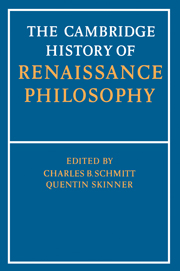23 - Appendices: The rise of the philosophical textbook
from PART 3 - SUPPLEMENTARY MATERIAL
Published online by Cambridge University Press: 28 March 2008
Summary
THE NATURE OF THE PHILOSOPHICAL TEXTBOOK
We must start by defining what is meant by ‘textbook’, a modern term more or less equivalent to other formulations such as manual, cursus, or systema. In the most general way a textbook can be said to be a book specifically designated for classroom use. As the universities developed from the twelfth century onwards, it was the writings of Aristotle which dominated in most scientific and philosophical subjects. In general for the Middle Ages and Renaissance down to the end of the sixteenth century, classroom instruction in philosophy was based upon a direct reading of Aristotle's works in Latin translation, though there were some exceptions. The one branch of philosophy where a manual derived from Aristotle replaced a reading of the master's works quite early was in the field of logic. Thus, Porphyry's Isagoge and the De sex principiis had both become a part of the Aristotelian logic corpus by the high Middle Ages. In the thirteenth century other manuals came into play, the most famous example being Peter of Spain's Summule logicales. Though not entirely absent from the Middle Ages and early Renaissance, textbooks covering other branches of philosophy were not nearly so common.
The philosophical textbook during the period with which we are concerned was nearly always a summary, exposition or expansion based on Aristotle. These often took the form of compendia, i.e., brief, simplified treatments of an Aristotelian text or group of texts. They could also, however, be of a more inclusive nature, expanding upon what was available in the corpus Aristotelicum.
- Type
- Chapter
- Information
- The Cambridge History of Renaissance Philosophy , pp. 792 - 804Publisher: Cambridge University PressPrint publication year: 1988
References
- 30
- Cited by

